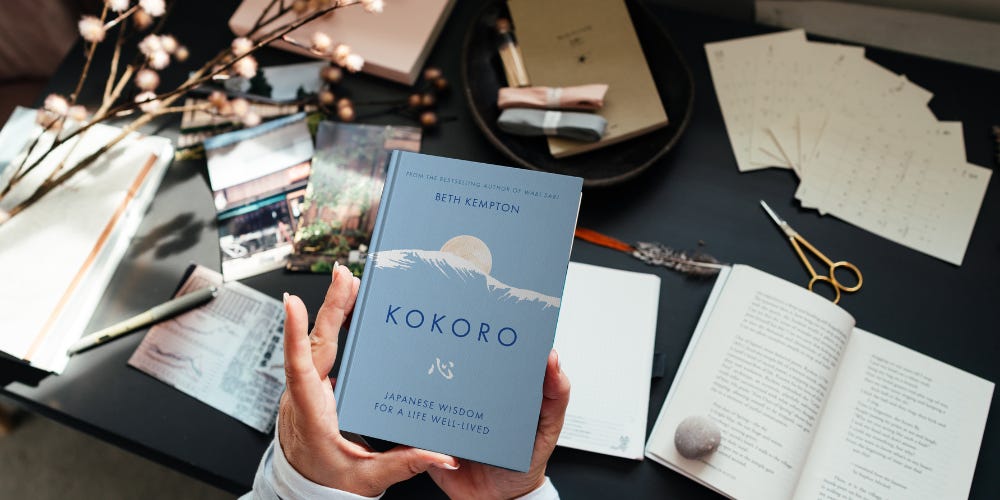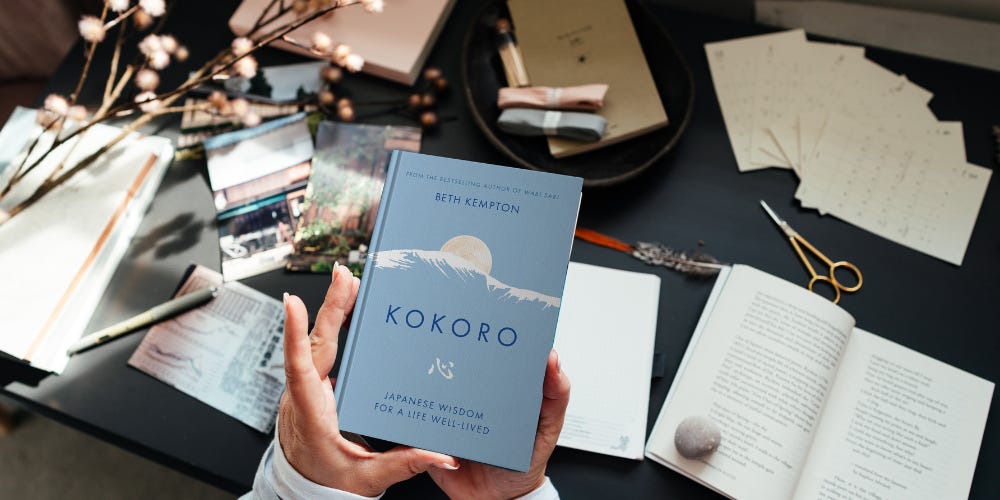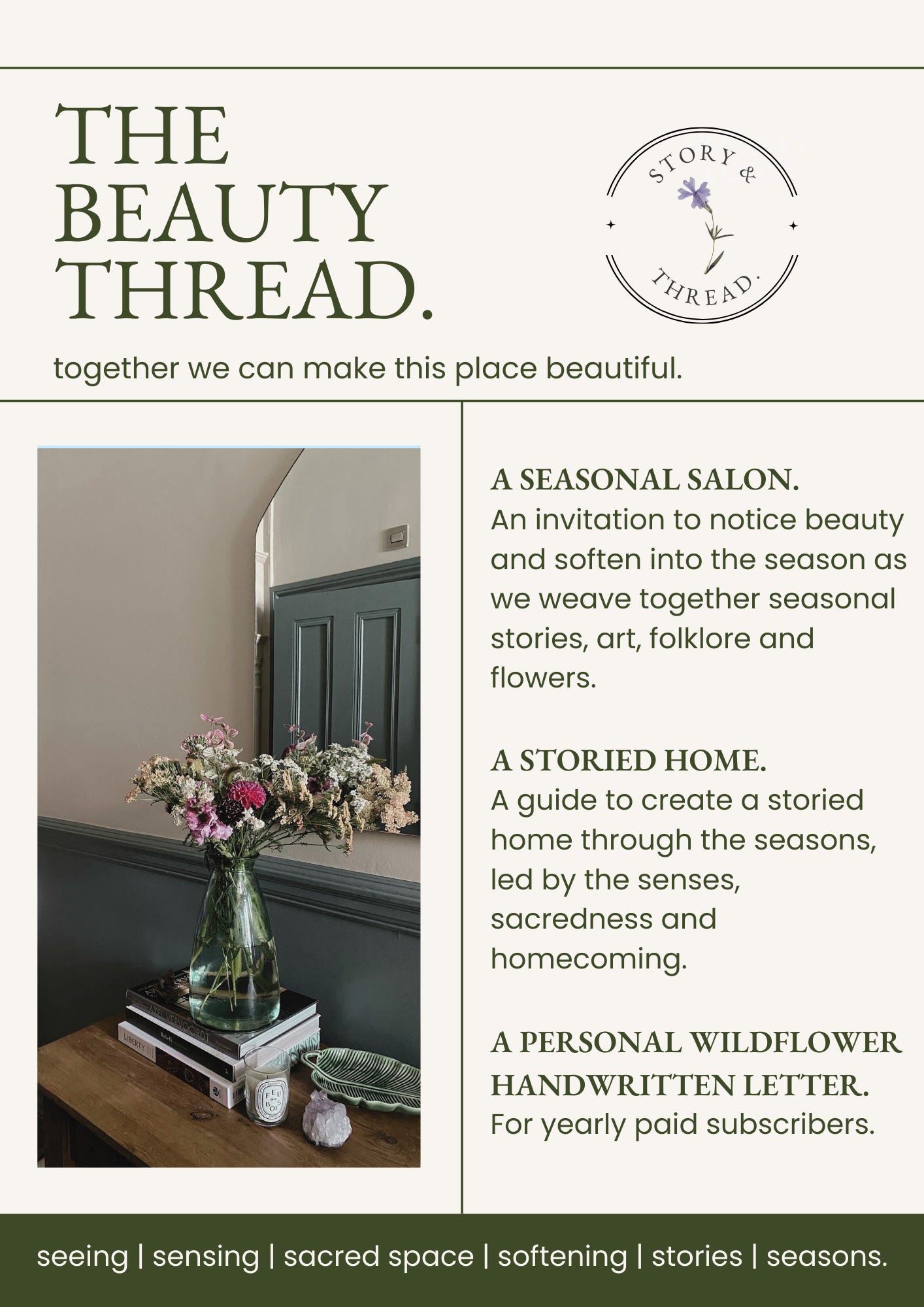How writing as ritual creates sacred space in our lives, with Beth Kempton.
#09 ATELIER, a collaborative interview series exploring our creative spaces, processes and rituals.
Hello, I am so glad you have found your way here… I’m Lyndsay — mother, creative and storyteller with a background in interiors PR.
Step inside Story & Thread., a cosy, layered home where the threads of creativity, interiors and mothering meet. Here, we unearth the stories from the seasons of our lives, with a house & a garden at the heart, and everyday beauty as our guide…
“Every time you step into your own sacred writing space to greet your words you change a little, grow a little. And then, when you are ready, you close the ritual, come back to your day and carry on, as if you haven’t just travelled to other worlds and back”.
—Beth Kempton.
Dearest reader
I am dropping in with a treat that I hope you will make for some cosy Sunday reading — the latest ATELIER interview, with best-selling author, writer mentor and Japanologist, .
Beth is the creator of SoulStack by Beth Kempton on Substack, and author of six books — including The Way of the Fearless Writer, Wabi Sabi: Japanese Wisdom for a Perfectly Imperfect Life, and her most recently published title, Kokoro: Japanese wisdom for a life well lived.
I have found Beth’s words and her approach to the craft of writing hugely inspiring, and life-changing in a number of ways. I loved learning recently that Beth published her first book in the last year of her thirties, the threshold year I have just entered — a time that feels like a potent portal as I deepen into my own creative dreams.
Beth’s SoulCircle writing community feels like both a sacred space and soul food — a place where Beth tenderly holds each writer, gently nudging each of us to uncover and put words to truths held deep within. I am so looking forward to the new offering within SoulCircle this autumn, The Book Dream Incubator, a place to dream a book into reality with Beth’s wisdom and experience of doing just that.
I am moved by the way that Beth describes writing as a subtle yet powerful ritual that transports us to other worlds whilst we sit at our desks, a feeling I closely identify with. I invite you to discover more about Beth’s own writing process, practices and her creative space in the latest instalment of the ATELIER series…
ATELIER, noun, [French atuh-lyey].
a workshop or studio, especially of an artist, artisan, or designer.
Tell me about yourself and your creative life.
I am a seeker of beauty and a lover of words. My creative life is a mishmash of writing, reading, question-asking, pondering, wandering, sometimes a bit of painting, and building a life that makes me feel free.
I have worked for myself for 14 years, and been a published author for the past seven, and I thank my lucky stars every single day.
I am also a mama to two young girls who are super creative in very different ways to me, which I find so inspiring. We love to make things together, and I love the way their brains work.
Where do you write?
I have a writing room under the back stairs of our old English cottage. It is very small and mostly taken up by two desks, one for my Mac and one for analogue writing. I spend a lot of time in here, especially very early in the morning (there is a direct view of the sunrise from the window) but a lot of my writing is done on the move. I live in the countryside so I walk and cycle a lot, often in the direction of a sweet café.
My main desk is actually an old workbench from a school science lab. It has a wooden top that's covered in scratches, and on the left, there's actually a hidden sink accessible by putting your fingers in a large hole and pulling up a chunk of wood. The stamped logo on the ceramic basin inside tells me that was made in Darlington by the School Furnishings Company long ago. The sink tends to collect tiny circles of paper which have escaped from my hole punch and fluttered in through the hole in the lid. It’s a good place to hide snacks.
The room has a very old flagstone floor, which is lovely and cool in the summer but in need of a rug in the winter. Last year I discovered the joys of writing with an electric blanket around my knees on cold and frosty mornings.
The shelves behind me are full of dictionaries, volumes of old literature and poetry and reference books about Japan, but the shelves in front of me are more open, full of bits and pieces that inspire me.
How do you like to approach a creative workday?
I have to be organised because I have two small children and a business. I have a plan for the week, although I’m pretty flexible if I’m not ‘feeling it’ when I come to write something.
I usually fit in a couple of hours of writing at 5am before the girls get up for school, then I do a couple of hours of work after drop off. 2-3 days a week I go to morning yoga or pilates. I often meet my husband at a café during the day to chat about ideas or business-related things (he works with me). In summer we sometimes have ‘board meetings’ on our paddleboards out in the water. Then I head back to my desk for a few more hours before the end of the school day.
I try not to work in the evenings but it depends what is going on. I do often work at weekends, but I am trying to do less of this. When I’m on a book deadline I often spend a few days in an Airbnb and will work very long hours interspersed with yoga, walking and café visits.

Are your surroundings important to you?
Very. I adore living in the countryside with farmland and the sea on my doorstep and I get out in nature almost every day. My writing space is a museum of things that hold stories for me — to other people they might look like junk but the feathers and stones and teapots and old photos all have meaning. I also surround myself with books but sometimes, often when I am embarking on a big new project, I clear the decks and start with as much white space as possible.
When I write in cafés I prefer places with a gentle hum of conversation, fresh flowers on the table, a comfortable chair to sit in and good coffee or a nice cup of tea. I do also like writing on the road — a number of my books include stories of my travels and I find that I open to the world in a different way when I am away from home.
I think it's quite interesting to pay attention to what you surround yourself with, because it can distract from your practice, or support your practice. Here's what you'll find where I write:
An old teapot from Kyoto, a bell from the Portland Japanese Garden. A jam jar full of homemade writing prompts. A few pots holding pens, pencils, paint brushes, scissors and feathers. A pair of meditation bells joined by a thin strip of leather, a wild gorse candle, some matches. Some aura spray from the Chalice Well Garden in Glastonbury were I often go to write. A paper cup covered in scribbles. Some tiny vases with flowers in. A small globe, which spins at an angle. A couple of books of poetry with covers in a calm colour. Twenty-three crystals, my diary, an omamori protection charm Meiji Jingu, with edges of fraying purple silk. A framed picture, some hand cream, an aromatiser and a bunch of essential oils, and a wooden sign which asks ‘What are you waiting for?’. An Instax Polaroid camera sits alongside a chipped mug full of receipts, far too much washi tape, some affirmation cards and a lot of notebooks used and new.
These are all things that I use one way or another in my writing, sometimes in a ritual, perhaps as a memory prompt, or simply to remind me what I came to this desk to do, to write, to practice writing. To write in order to wake up.
Having said all that, I do believe that a sacred writing space does not have to be a physical place. It can be a state of the heart that you enter through ritual and silence.
How do you like to feel whilst you are working?
Relaxed, quiet, inspired.
How do you set the tone and energy of your environment?
Always a candle. Notebooks and poetry books at hand. Sometimes music, sometimes silence.
Where do you source creative inspiration?
Life! There is inspiration everywhere. I go for walks, write about what I see and conversations I overhear and read poetry and beautiful prose. Mostly I ask questions and listen for answers.
Do you have any rituals around your work?
I tend to wake before 5am these days and go downstairs in the dark. I switch on the fairy lights in the kitchen and put the kettle on. While the water is boiling I do a simple movement sequence to loosen up my body. Then I make tea and toast, take it into my study and close the door behind me. I sit at my desk, where my notebook and pen are waiting, along with a candle and a box of matches. I take a few deep breaths, inhaling the gentle energy of early morning, then I light the candle and welcome a new page.
I write the time, the date and the place, anchoring myself to the moment, a still point in the rushing river of life. Then I write what I notice. Still dark. Silver rain is falling from the street lamp. The hot water just clicked on. Every day is slightly different, depending on the season.
Often I read some poetry, a short passage from a favourite book, or some words of my own. It’s usually enough to set the words flowing. If I don’t feel any words bubbling up, I might meditate on the candle for a while and come up with a question. Then I’ll respond to that question in my notebook, and off I go.
The ritual signals that it’s time to write. When you approach writing with this kind of ritual, you never really have a blank page.
We tend to organise our days as if they are linear, but I think that when you begin a writing session with a ritual, you carve out a circular space off to the side of your day. You leave the day at a given point – and come back to it. A casual observer might think that just a few minutes have passed and nothing special has happened, but you know the truth. For a while you entered a place where time bends, ideas hover and anything is possible.
Every time you step into your own sacred writing space to greet your words you change a little, grow a little. And then, when you are ready, you close the ritual, come back to your day and carry on, as if you haven’t just travelled to other worlds and back.
What would your dream creative studio space look like?
I love my space at the moment but my children are small and it’s so tempting for them to just come in and disturb my train of thought. When I’m working on a book I do tend to hang an old library sign which says ‘Silence please’ on the door, but that can feel like I am shutting them out so the ideal would be to have a separate place I can escape to.
I would love a cabin in the garden, with pot plants around the door, a tiny soundproof podcasting studio the size of a cupboard at one end, and long wide windows with both standing and sitting desks. I’d have an armchair, and shelves for my bits and pieces, a stack of books on the go and a kettle. In the dream there’s a wood burner too. I am working on it! Stay tuned…
To be honest I’m just grateful that I get to read and write and ponder life’s big questions and call it work, so I’d quite happily write from anywhere.
Beth Kempton is a Japanologist and a bestselling self-help author and writer mentor, whose books have been translated into nearly 30 languages. She has had a quarter-century love affair with Japan, and has made it her work to uncover life lessons and philosophical ideas buried in Japanese culture, words and ritual. Beth has two degrees in Japanese and has a rare understanding of Japanese cultural and linguistic nuances. She is also a qualified yoga teacher and Reiki Master, trained in the Japanese tradition in Tokyo. Her sixth book, Kokoro: Japanese wisdom for a life well lived is a follow up to her earlier bestseller Wabi Sabi.
More than 40,000 people have taken Beth’s online writing classes, which complement her book The Way of the Fearless Writer. With more than 35,000 subscribers, Beth has one of the UK’s most popular author publications on Substack, SoulStack by Beth Kempton.
As a mentor, Beth offers support and inspiration to writers and dreamers, teaching how words and ideas can heal, inspire, uplift, connect, and help us make the most of our time in this beautiful world. She has mentored dozens of authors to publication, including with some of the world’s most well-known publishers. She is also founder of Do What You Love, a company which produces and delivers inspiring online courses for living well.
Beth also has an incurable addiction to chocolate and Japanese stationery. She lives a slow-ish life near the sea in Devon, England. Beth is the mother of two small girls who fill her with joy every single day. She also adores Christmas, and her Calm Christmas Podcast, created to accompany her book Calm Christmas and a Happy New Year, is officially the UK’s #1 favourite Christmas podcast. She believes that life is too short for ironing, and for not doing what you love.
You can find Beth in the following places online:
*SoulCircle, home of Beth’s beautiful, gentle community for writers and dreamers.
*Calm Christmas with Beth Kempton, a new seasonal Substack and new home of the Calm Christmas podcast.
bethkempton.com | dowhatyouloveforlife.com | Instagram @bethkempton
I loved learning how Beth’s weaves gentle intention into her writing practice in order to both root to time and place, whilst travelling to other worlds of possibility.
How do you bring ritual into your writing practice, and life?
Thank you so much for reading, I hope you enjoyed this glimpse into Beth’s creative world as much as I did — as always, your thoughts are very welcome in the comments.
The Beauty Thread., is a new paid membership within Story & Thread. Through a series of seasonal offerings, The Beauty Thread. is an invitation to notice, hold and create beauty in our own worlds, woven together by the ever-changing seasons, both around us and within us. When we come to know beauty, it transforms us, the onlooker, into an exquisite piece of life’s tapestry. For my birthday season of autumn, subscriptions to The Beauty Thread. will cost an introductory price of £5 per month or £45 per year.

















What a beautiful atelier today Lyndsay
I'd saved this post to read when I knew I absolutely would not be interrupted so I could soak in both of your beautiful writing, Beth & Lyndsay. What a dream collaboration. I particularly love your morning ritual around writing Beth. I aspire to this (when my son finally chooses to sleep through the night). Thank you both 💛